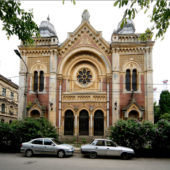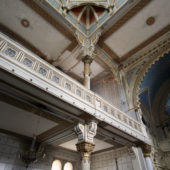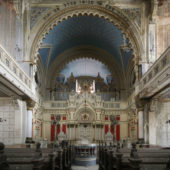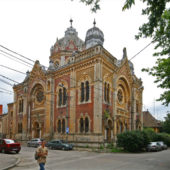This majestic synagogue, one of three in Timosoara, now serves only a small congregation.
An impressive example of a harmonious fusion of styles including Moorish, Gothic and Baroque, the Fabric New Synagogue of Timosoara, fit comfortably into a city once known as “Little Vienna” thanks to its elegant architecture.
Constructed around the turn of the 20th Century (varying dates are given from 1889 to 1908), the synagogue was designed by highly respected Hungarian architect, Lipot Baumhorn. The building site itself had been occupied by another synagogue that had been in use since around 1840. Baumhorn’s design incorporated multiple cupolas and a large central dome atop an imposing redbrick structure. Latticed rosette windows set within gables ornament each side of the building’s façade. Smaller rosettes are set around the synagogue’s dome while arched windows on all sides ensure ample light within.
The interior of the synagogue is a cornucopia of colorful embellishments ranging from the ornate column capitals to the elaborately carved and painted bimah and ark. A second floor balcony featuring coffer-like ornamentation looks down upon a spacious main gallery with rows of dark, wooden benches.
The Romans built a fort in Timosoara in the 2nd Century and by the 13th Century it had become a settlement of some significance. A Jewish presence has existed in the surrounding province since Roman times, but it wasn’t until the 18th Century that Jews were first recorded as city residents, a time when Timosoara was under Ottoman rule.
By the 19th Century, the Hapsburgs had reclaimed the area from the Turks and with the reconciliation of the Austrians and Hungarians, the city became part of the Austro-Hungarian empire. This was largely a happy and prosperous time for Timosoara’s Jews, who numbered about 7,000 during the 19th Century.
This community constructed six synagogues of which Fabric is one of three remaining. Only one is used for services today. The Second World War & later emigration in the 20th century diminished Timosoara’s Jewish population to a mere 200 or so, out of a total population of around 311,000. Unfortunately, this no longer used synagogue is now slowly crumbling, its paint fading and the structure is in need of significant repair.
During its heyday, the Fabric Synagogue was one of the most handsome in a country filled with many attractive synagogues. Its congregation was classified as Neolog, part of a mild reform movement within Judaism around the turn of the 20th Century. Neologs, who resided mainly in cities, welcomed modernization and hence had a more moderate religious position than their more orthodox brethren.




